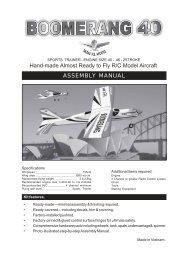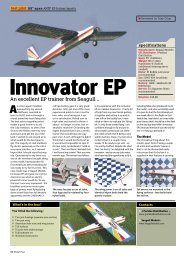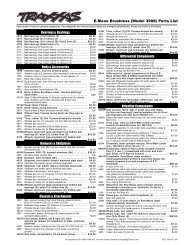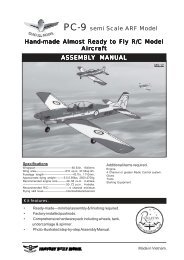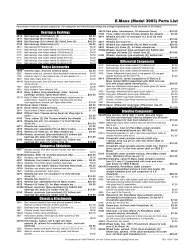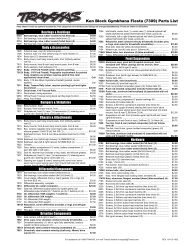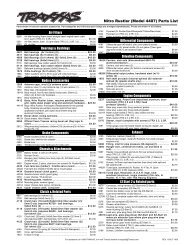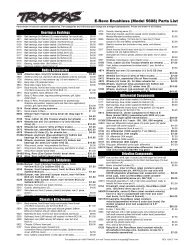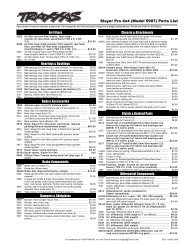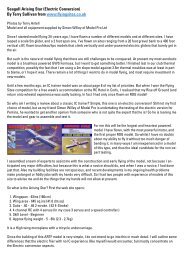md tucan 5sp.pdf, pages 49-64 - Multiplex
md tucan 5sp.pdf, pages 49-64 - Multiplex
md tucan 5sp.pdf, pages 49-64 - Multiplex
Create successful ePaper yourself
Turn your PDF publications into a flip-book with our unique Google optimized e-Paper software.
10. Installing the tail servos (pic. 18 & 19)<br />
Connect a 30 cm long servo extension lead, # 8 5031, to the<br />
Tiny-S rudder servo, # 6 5121, and tape the Uni connectors<br />
to prevent them working loose. Cut down the servo output<br />
lever to the length shown in Fig. 18, and thread the rudder<br />
pushrod 47 (1.5 Ø x 80 mm) through the servo output arm<br />
using the hole shown. Feed the servo lead through the<br />
duct in the fuselage, and place the rudder servo - with<br />
pushrod attached - in the appropriate recess. Check from<br />
the transmitter that the servo is at centre, then fix it to the<br />
foam by applying hot-melt glue to the mounting lugs. Set<br />
the rudder to centre (neutral), and tighten the grubscrew<br />
in the barrel connector. Tighten the servo output screw to<br />
secure the output arm.<br />
11. Preparing the wing retainer system (pic. 20 & 21)<br />
Glue the circular plywood discs 33 to the transverse plate<br />
32, then press the captive nut 44 (M6 x 8 mm) into the hole<br />
from the underside; you may need to tap it into place with<br />
a hammer. Secure the nut with adhesive.<br />
Glue the two side pieces 31 to the sub-assembly you have<br />
just prepared.<br />
12. Gluing the wing retainer system to the wing centre<br />
section (pic. 22 & 23)<br />
Place the wing retainer assembly in the top of the wing<br />
centre section 9, position it accurately, and glue it in place.<br />
Glue the former 35 to the foam part.<br />
Slide the CFRP tube 72 (8 Ø x 370 mm) into the foam<br />
part from the side, and pass it through the openings in the<br />
wing retainer assembly. The tube should end flush at both<br />
sides. Glue it in the correct position, applying adhesive to<br />
the whole surface.<br />
13. Gluing the outboard wing panels to the centre section<br />
(pic. 24)<br />
Apply adhesive to the mating surfaces. Place the righthand<br />
outboard wing panel 8 on the centre section 9 from<br />
above, and position it carefully. It is a good idea to spray a<br />
little activator on the surfaces to ensure that the joints cure<br />
quickly. Repeat this procedure with the left-hand outboard<br />
wing panel 7.<br />
14. Gluing the spars to the wings (pic. 25)<br />
Cut down two GRP rods 73 (1.3 Ø x 510 mm) to a length<br />
of 480 mm. Glue one part 73 and one CFRP tube 71 (8 Ø<br />
x 470 mm) in the appropriate channels in the underside of<br />
each wing panel.<br />
Note:<br />
Lay each wing panel down flat when working on it, to avoid<br />
warps.<br />
15. Completing the ailerons (pic. 26 & 12)<br />
Prepare two aileron horns 38 as described in Step 7; take<br />
care to produce a handed (mirror-image) pair, as shown in<br />
Fig. 12. Glue the horns 38 in the recesses in the underside<br />
of the aileron of each wing panel.<br />
Cut through the ailerons at each end to release them. Move<br />
the ailerons up and down to free up the hinges, but take<br />
care not to deflect them too far - on no account separate<br />
the ailerons from the wings!<br />
16. Installing the wing-mounted servos (pic. 26)<br />
Cut down the output arms of the Tiny-S servos, # 6 5121, as<br />
shown in Fig. 26. Connect the aileron pushrods 46 (1 Ø x 50<br />
mm) to the output arms, and fit the servos in the outboard<br />
wing panels 7 and 8. Check from the transmitter that the<br />
servos are at centre, then fix them to the foam by applying<br />
hot-melt glue to the mounting lugs. Connect a 30 cm long<br />
servo extension lead, # 8 5031, to each servo. Finally set<br />
the ailerons to centre (neutral), and tighten the grubscrews<br />
in the barrel connectors.<br />
17. Installing the undercarriage mountings<br />
(pic. 27 & 28)<br />
Glue the undercarriage mount 36 to the reinforcements<br />
34 as shown in Fig. 27 to produce the mounting for the<br />
right-hand undercarriage unit; check that the holes line up<br />
accurately.<br />
Repeat this procedure for the left-hand side, using the<br />
plywood parts 36 and 2 x 34. It is important to produce two<br />
mirror-image sub-assemblies (different left and right).<br />
Place the right-hand undercarriage mounting in the appropriate<br />
opening, position it carefully, and glue it in place.<br />
Repeat this procedure with the left-hand wing panel.<br />
18. Installing the fixed main undercarriage (included in<br />
the kit) (pic. 29-33)<br />
All the parts required for this stage can be found in the bag<br />
marked “Tucan undercarriage set”.<br />
Drill a hole of around 4.5 mm Ø at the points marked L and<br />
R in the plastic main undercarriage brackets 62. Slide the<br />
wire main undercarriage legs 58 & 59 through the brackets<br />
from the underside, and screw these assemblies to the<br />
covers 63 using the self-tapping screws 67 (2.9 x 9.5).<br />
The undercarriage assemblies can now be installed in the<br />
outboard wing panels 7 and 8 as shown in the illustrations,<br />
using the self-tapping screws 67 (2.9 x 9.5).<br />
Screw an M3 x 3 socket-head grubscrew into each collet 68<br />
(4 mm) to a depth of about three full turns. Slip one collet<br />
68 / 69 onto each wheel leg, followed by a wheel 61 and<br />
another collet 68 / 69. Position the collets in such a way<br />
that the wheels rotate smoothly and freely, then tighten the<br />
socket-head grubscrews firmly.<br />
Seite 17




